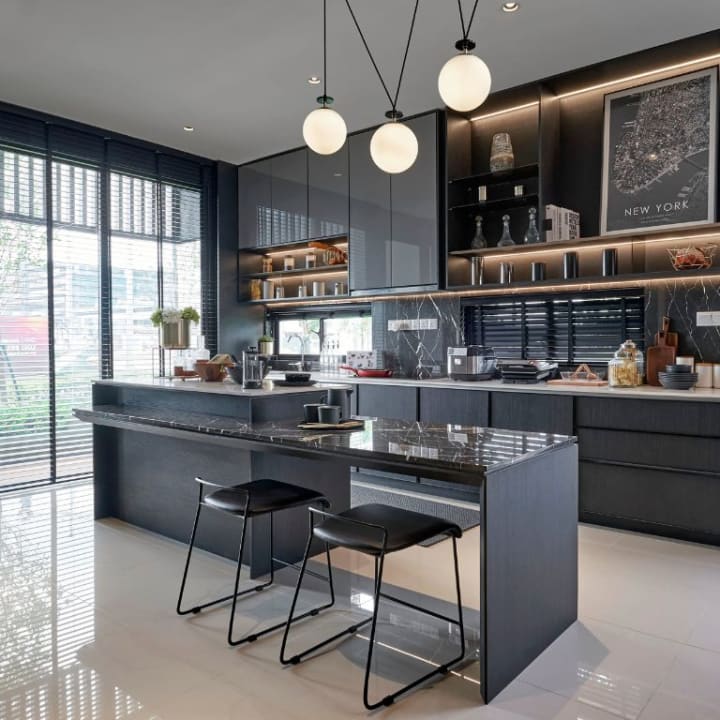How to create a kitchen that resembles an Interior Design Professional
Popular Kitchen Interior Design in Bangalore or How to create a kitchen that resembles an Interior Design Professional

It is important to plan carefully to ensure that a kitchen is beautiful as well as useful. Here are 12 concepts from our interior design firm to keep in mind as you design the kitchen of your dreams.
The kitchen is the centre of your home's activities, that is where you can enjoy all kinds of things from quick breakfasts before heading out the door, to dinner parties with the family or an afternoon tea with your friends. Your kitchen is a place where you are most comfortable cooking and cleaning, eating, or hosting. These ideas will aid you in designing the kitchen you'll be happy with whether you're renovating your kitchen, or creating an entirely new one.
Use our suggestions for organising, planning and essential features to consider when designing your kitchen layout that creates an appealing and efficient area that will meet your requirements.
1. Get rid of unnecessary items:
Think about your most frequent tasks when planning the layout in your kitchen. Arranging everything you require to complete a task close to one another will help you save time and effort. For example, place all your coffee supplies like mugs and grounds, near your coffee machine. Your tired, early-morning self will appreciate this! Also, keep plastic wraps and containers in a convenient place close to the work space to wrap leftovers. Set the flatware and dishes close to the dishwasher, making unloading simpler.

2. Create spacious pathways between counters and the island
Make sure that the space you have in your kitchen's floor plan is in between your island as well as cabinets, which allows for ease of movement. Kitchen paths are usually at least 36 inches long. For instance, a single-cook kitchen will require an aisle of 42 inches in width, while the two-cook kitchen will require an aisle of with a width of 48 inches. Kitchen peninsulas and islands should be designed accordingly.
3. Encourage your guests to explore the kitchen.
When laying out the kitchen, the flow of traffic is a crucial aspect to take into consideration. The cook shouldn't be often running into guests when they move in and out of the kitchen. Make sure the stove isn't placed in the middle of an area where there is a flow of traffic from the kitchen area to another space.
The kitchen's work area is distinct from the social area of the kitchen using an island in the middle. It keeps friends and family members from obstructing the kitchen while still allowing them to interact about cooking with the kitchen. Also, make sure that everyone who is working at the kitchen, cleaning the kitchen area or bystanders can be able to reach the refrigerator.

4. Beware of corners.
When choosing where to put appliances and cabinets Pay attention to the corners. You should include space for the door's clearance and the direction of the swing in the kitchen layout to ensure that the cabinet doors and appliances are useful. Appliances shouldn't be placed in the corners, and doors shouldn't slam into each other when they're opened simultaneously. Handles with a low profile are the best option if you need to manoeuvre around the corners of a room. However the handles that are too prominent on knobs, pulls, as well as appliances can make it difficult to open the doors to corner cabinets adjacent to them.
5. Find the proper microwave's height.
Based on the cook's preference or how child-friendly your kitchen area is, the microwave's optimal height and location may vary. The best adult microwave's height is around 38 cm higher than the countertop. However, placing it under the counter might be more secure and acceptable for children to make use of the microwave.

6. Determine the purpose of the island.
Function is always first when it comes to kitchen islands. Before making a decision on the design, think about what you would like to do with the island within the interior space. Make sure you have enough space you want to cook or dine at the kitchen's island to ensure that the stove can be separated from the dining space. The island could also house other elements such as dishwashers or sinks for greater utility.
7. Create a landing space near appliances.
The landing of appliances provides the opportunity to quickly prepare hot food items that have just emerged from the microwave or oven. They can also help prepare the components also. It is recommended to include at minimum 38cm of counter space either side of a cooktop as well as a refrigerator when making the arrangements for your kitchen. Space for landing is crucial near other small appliances such as a coffee maker or toaster.
8. Take into consideration the finish on your countertop.
To help you choose a countertop, consider your demands for meal preparation. For instance, people who love cooking require more space for their counters as opposed to those who do not cook or make meals for themselves (preferably between the stove or sink). Additionally, having two counter sizes can help bake and also benefit children who help with meal preparation.

9. Utilize two of each kitchen appliances.
In organising your kitchen, consider purchasing two of your frequently used kitchen appliances when you have a large family or lots of food demands. A second microwave, a mini-refrigerator or refrigerator drawer that is placed near the edges of the work centre in the kitchen will help spread the burden and keep snakes out of the cooking area. If you want a place for children to gather after school, you can add an area for snacking with stool.
10. Set the oven.
It is a good idea to keep essential cooking equipment in the immediate vicinity of the stove. Set up a shelf in front of or behind the cooker to keep utensils, spices and cooking oils within easy reach. Make sure to include extra-deep drawers for cooking equipment near the cooktop or underneath a cooktop while planning the layout for your kitchen. S-hooks located on the side of the hood on the range are a great way to hang pans and pots to create an open-plan kitchen.
11. Make sure to store knives properly.
Knives can be put on the backsplash using magnetic strips. Set it in the space of the counter that is usually used for preparation of ingredients. This will keep dangerous items from reach of children and allows you to identify the appropriate knife for the job easily.
12. Make recycling easier.
Set up areas for garbage and recyclables, making sorting as easy as is possible. Create a cabinet using distinct plastic, metal as well as glass bins. Papers from old newspapers and other recycled papers can be tucked away in a drawer that is not used.
Conclusion: Pick a place of focus.
Choose one distinctive element of your kitchen's design to be the main focal element. The focal point could be a backsplash tile with a design or a stunning flooring, a massive range hood, vibrant kitchen cabinets, or coloured countertops the best references took from Popular Kitchen Interior Designer in Bangalore. After you've chosen your focal spot, you can enhance the look with some delicate, yet striking accents.
About the Creator
Ashok Suthar
A talented SEO specialist for Stories Design Studio Interior Designer in Bangalore, Stories Design Studio brings spaces to life with flair and functionality. With over a decade of experience and a track record of transforming spaces






Comments
There are no comments for this story
Be the first to respond and start the conversation.